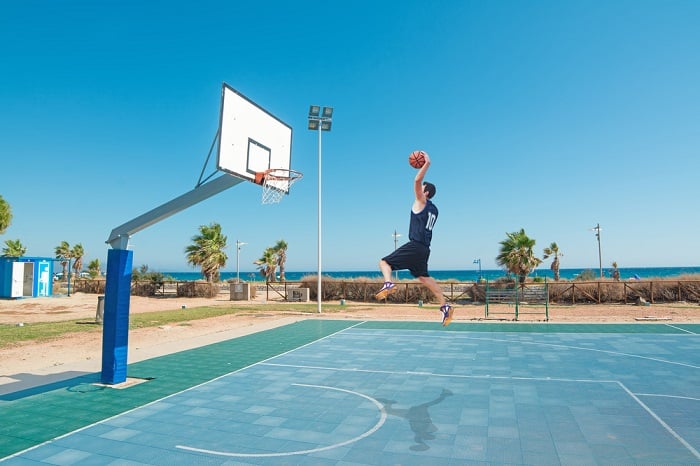- Is Basketball A Winter Sport – A Definitive Answer [2023] - January 27, 2022
- Why Do Basketball Coaches Wear Suits – Full Answer [2023] - January 25, 2022
- Can You Use Basketball Shoes For Wrestling? (No, Here’s Why) - January 6, 2022
It’s no wonder that dunking is such a popular move.
Dunking is an amazing display of strength and grace – it’s poetry in motion. There’s nothing like seeing a player fly through the air and slam the ball through the hoop.
It always gets the crowd going wild! So how tall do you have to be to dunk?
The optimal height for dunking is over 6 feet tall. If you are shorter than 6 feet tall, it can still be possible to dunk; however, the odds go down.
This blog post will discuss the dunk (in all its glory) and its relationship with height.
So, without further ado, let’s get started!
Contents
How Tall Do You Have To be to dunk?
You have to be at least 6 feet or 182.88 cm to dunk comfortably. If you’re shorter, you can still dunk, but it will be harder for you, especially on a standard-sized basketball hoop. The good news is that it’s possible to increase your vertical leap to dunk more effectively.
The 5 factors of dunking
If you want to dunk a basketball, these are the five factors that determine your success.
- Height
- Vertical leap
- Wingspan
- Ability to palm the ball
- Overall strength/mass
First off, let’s get this obvious factor out of the way. As you may have seen from famous dunkers such as Vince Carter, height gives you a clear dunking advantage.
At 6’6″, Vince Carter’s height gives him a significant advantage in dunking compared to a player who is 5’7″.
Height is not the only requirement for dunking; you also need an explosive vertical leap.
Vertical Leap
What does vertical leap have to do with dunking?
High leapers tend to be more successful at dunking because they can quickly elevate themselves to the rim.
Nate Robinson was a tiny NBA player who could soar above the rest.
Standing at 5’9″ and with an amazing 43.5-inch vertical leap, Nate holds the record for winning three Slam Dunk Championship trophies as well!
Being a strong leaper also means having a high power to weight ratio.
Power to weight ratio is important in helping you hold your own against defenders and complete the dunk. Great vertical leap also helps in soccer. As a suggested read, check out “basketball vs. soccer“.
The importance of wingspan when dunking
To dunk, it helps if your arms are long (i.e., if you have a wide wingspan).
The scientific community and researchers refer to this as “standing reach”, however, NBA scouts, coaches, and GM’s commonly use the term wingspan.
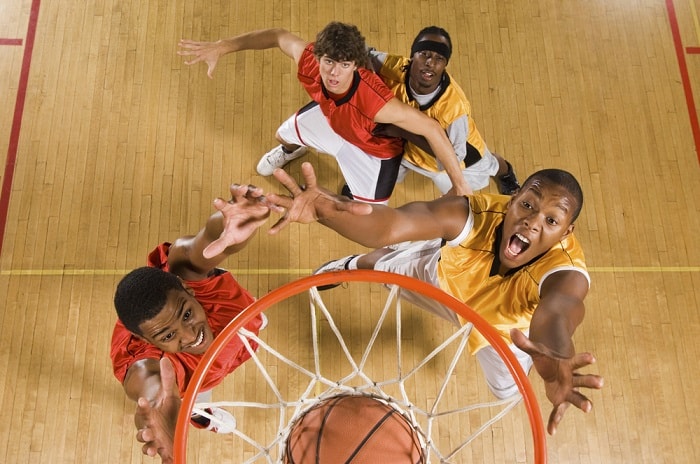
Long arms are the best for dunks because they take the ball places quickly.
Even without you shifting your feet!
A player who has a long wingspan may be able to dunk without jumping as high (and vice versa).
Wingspan is especially useful when clearing heavy traffic around the basket or when someone is contesting the dunk.
There are only a few such players in the NBA right now with incredible wingspan, and that’s one reason why they’re called “unicorns”:
- Giannis Antetokounmpo
- Kevin Durant
Giannis is freakishly tall and has a wingspan of 7 foot 3 inches. The “Greek Freak” is the NBA’s most prolific dunker, averaging over 4.8 dunks per game.
Explore the impact of wingspan by watching this expert analysis on Giannis:
Kevin Durant, on the other hand, is known as the “Slim Reaper”. His name is a reference to his intimidating and lanky body type (and the damage it inflicts on his opponents).
KD is a top-10 league leader in dunking, which speaks volumes for the power of wingspan!
If you want to dunk like him at the comfort of your home, then you need a portable basketball hoop for dunking.
Palming Ability
One of the essential aspects of dunking is being able to palm the ball.
Palming a basketball is the act of holding a basketball by controlling it with one hand through contact with the palm.
Being able to palm the ball allows you to manipulate it into scoring positions while keeping it away from defenders.
This also explains why having large hands makes it easier to dunk; it gives you more surface area to palm around the ball and thus more control.
How strength and mass affect dunking ability
Remember the equation Force = Mass x Acceleration?
Your strength and mass determine how easy you can drive to the basket.
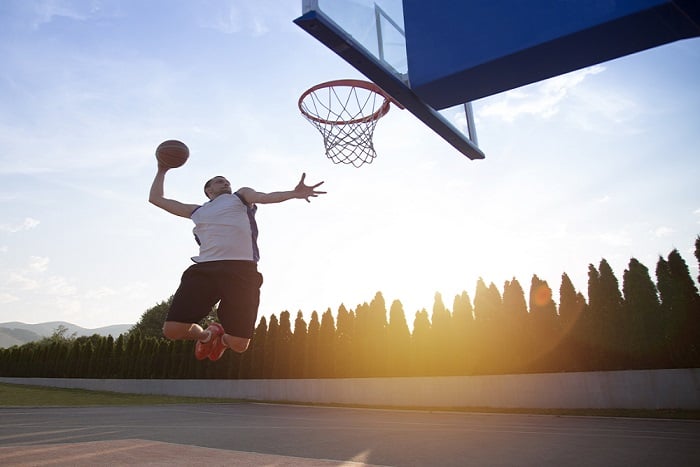
They also contribute to how hard you can elevate and slam a ball into the hoop.
Lebron James is 6 feet 9 inches and has a 250-pound frame; this makes it easier for him to muscle through the defense.
Zion Williamson is another player built like a battle tank.
Standing at 6’6″ and weighing close to 300 lbs, he bullies defenders on his way to the rim.
Do you have to be 6 feet Tall to slam dunk?
No! You can dunk a basketball at heights below 6 feet. Just look at players such as Allen Iverson, for example! You can make up for any lack of height with wingspan, vertical leap, and dunking technique.
Some tall people may have an advantage over shorter people, but a shorter person can still dunk. It just takes a lot of practice to increase your vertical leap!
Dunking at each height: what’s the difficulty?
- Dunking at 5’5″: Few people can accomplish this feat. Only the top percentile athletic leapers can hope to achieve this.
- Dunking at 5’10”: It requires a great degree of coordination, strength, and power. Not many people can dunk at this height!
- Dunking at 6’0″: It’ll be a little easier for you than someone below six feet. You’re taller, have a longer wingspan, and typically have more strength/mass.
- Dunking at 6’4″+: Most players at this height can play above the rim. In addition, players don’t need as high of a vertical leap at this height to dunk.
What’s better for dunking: jumping off of one foot or two?
There are a few advantages to each technique.
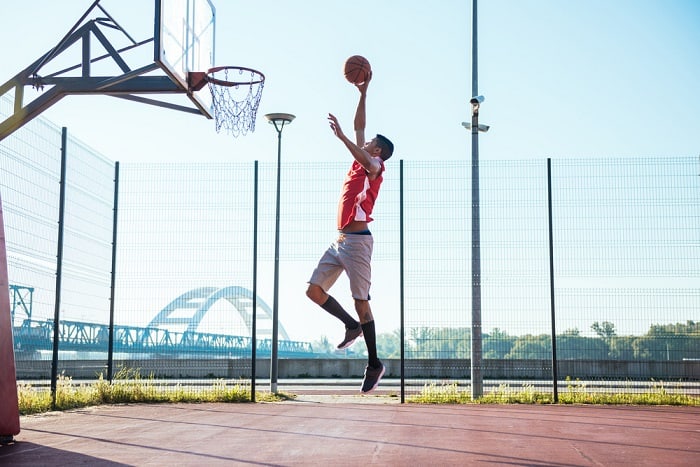
One foot:
- Faster finishing at the rim
- Allows you to extend your body closer to the rim
- You can get a higher vertical leap if you prefer this method
Two feet:
- You have more stability and balance on your feet
- It’s useful in traffic or when absorbing contact
- Jumping off two feels more comfortable and natural to some people
Sure enough, it’s also important to wear the right clothes when playing basketball. Having comfortable gear when dunking is a must.
how to increase your vertical leap and dunk effectively?
To dunk effectively, we suggest developing your strength, power, and leaping ability.
Great news – unlike your height, this is the variable of the dunking equation you can improve!
To increase your vertical leap, try doing plyometric exercises. These exercises involve explosively contracting your muscles.
Plyometric training increased vertical jump height by 4.7% to 8.7%, according to a University of Zagreb study.
The main focus of these exercises is to strengthen your fast-twitch muscle groups.
What’s the difference between fast twitch and slow twitch muscles?
Fast-twitch muscles give you explosive bursts of power, while slow-twitch muscles are more for endurance.
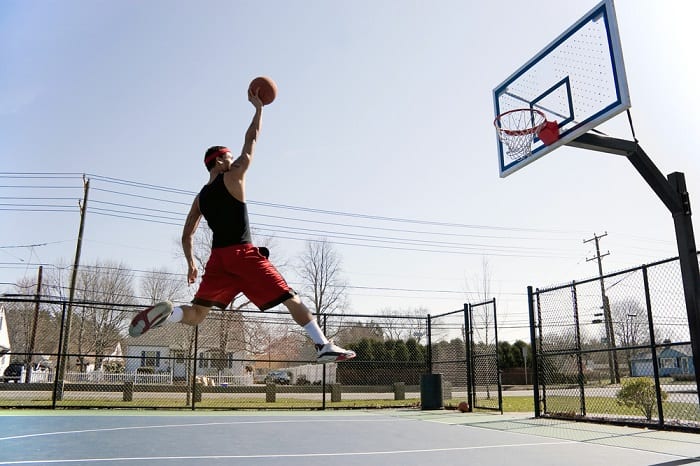
We know for sure that most professional basketball athletes have a high degree of fast-twitch muscle fibers in their bodies because they need quick bursts of strength and power.
How do I increase my vertical leap?
To increase your vertical leap, we encourage you to build strength and explosiveness in your training.
A Journal Of Sports Science & Medicine study revealed that eight weeks of jump squat training led to simultaneous improvements across 68 men in:
- Maximum Strength
- Vertical Jump
To do jump squats:
- Stand at the edge of a box and jump up onto it with both feet.
- Step back down and repeat. You can make this exercise harder by changing the height of the box.
- In addition to using a box, you can also use benches or steps.
- Perform three sets of 10-15 jumps on a plyometric box with at least 1 minute of rest in between sets for best results.
Increasing vertical leap: exercises for a powerful lower body
We also recommend increasing your vertical leap by doing squats, deadlifts, and lunges. These exercises target the fast-twitch muscle fibers in your body to build explosiveness.
8-weeks of squat training increased vertical leap performance by 12.4% in a Wirth 2016 study.
To do weighted squats:
- Stand with your feet shoulder-width apart and hold a bar over your shoulders behind your head with an overhand grip.
- Thrust your hips and lower your body as deep as possible, making sure not to let the heels come up off the floor.
- Then, push yourself back to starting position.
Deadlifting
Texas Tech University concluded that jump performance improved by 7% after 10-weeks of deadlifting twice per week.
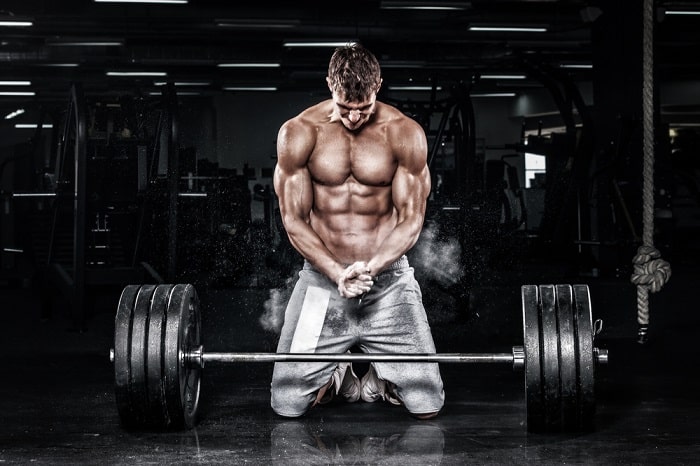
To do deadlifts:
- Place your feet about hip-width apart by slightly bending your knees.
- Pick up a barbell in front of you with an overhand grip.
- Push through your heels to lift the bar as you thrust your hips forward and bring them up to waist height.
- Slowly lower the weight back to starting position.
To perform lunges:
Lunges strengthen your quads, hamstrings, and glutes while also increasing your range of motion – which is essential for jumping power (and dunking).
- Take a big step forward with your right leg so that both legs are going to be bent at a 90-degree angle.
- Keep a slight bend in the left knee and drop the hips until the right thigh is parallel with the floor.
- Keep your back straight, thrust forward from your hips, and bring yourself back to starting position by pushing through your heels.
- Repeat on the other side.
Toe raises
Toe raises are an excellent way to strengthen the entire ankle, including muscles that support it.
The focus should be on lifting your toes off of the ground and lowering them again with each repetition for best results!
- Start by standing with your feet shoulder-width apart and your arms at your sides.
- Slowly lift your toes off of the ground, and then lower them back down.
- Repeat this process for 12-15 repetitions.
Calf raises
Calf raises focus on the muscles in your lower leg. Stronger calves mean more explosive power according to this study!
To do calf raises:
- Stand with your feet shoulder-width apart and slowly raise up on the balls of your toes as high as possible without bending forward at the waist.
- Hold for a second or two before lowering back down onto flat feet.
Depth jumps
Depth jumps are an effective way to improve your explosive power for dunking.
To do these types of jumps
- Start on a box or bench and step up onto it.
- Step off of your box, land in a quarter squat, and immediately explode into a vertical aerial extension (jump and extend hands above head)!
For added resistance, you can experiment with depth jumps in the sand. Studies show that sand activates different muscle groups.
Try split testing land depth jumps vs. sand depth jumps to see which one gets you better results!
Strengthen your core
While you can increase your vertical leap with plyometrics and high-intensity strength training, you’ll also need to develop your core muscles.
You don’t realize it, but the majority of your power comes from your center of gravity—your abs!
The more powerful and efficient they are, the higher you’ll be able to jump.
Here are 3 core exercises to improve your vertical leap:
Can you dunk if you’re short?
Absolutely yes! All you need is some creativity and a lot of hustle.
One way to dunk when you’re not tall is to use your body to create leverage. For example, try jumping off one foot and building momentum with your other leg, arms, and core.
You can also try bouncing the ball into the air (giving yourself an alley-oop).
If you’re close to dunking, but not there yet, try jumping without the ball in your hands to give you an added boost.
After lobbing the ball into the air, let it bounce, and meet the ball at the rim mid-leap and jam it home.
Height can be a limiting factor when dunking, but it’s not insurmountable.
FAQs
What’s the average standing reach by height?
The average player in the NBA Draft Combine has a standing reach about 1.335 times as long as their height!
NBA players tend to be longer (on average) than the Average Joe.
Therefore, multiplying your height by 1.30-1.32 is a safe and easy way to find average standing reach.
What’s the average height of NBA players?
The average height of NBA players is about 6’7″.
For reference, the tallest players to play in the league are Yao Ming at 7’6″ and the shortest is Mugsy Bogues at 5’3″.
Who is the shortest person to dunk?
Muggsy Bogues, standing at 5’3″, was the shortest person to dunk in NBA history. He still holds many other records today!
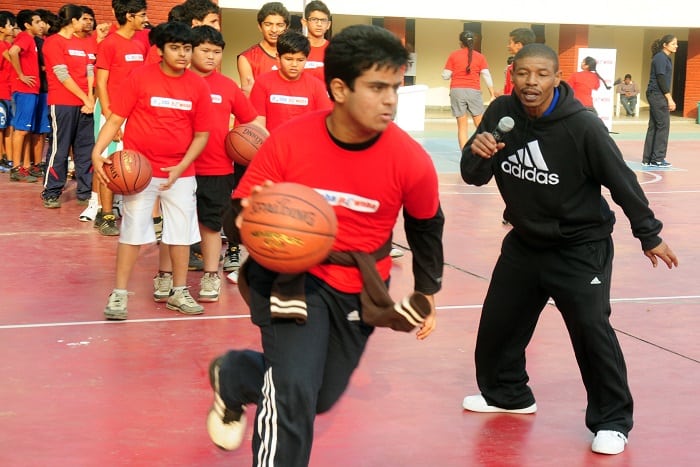
There are also unofficial reports of a 5’2″ nonprofessional player – William Easton – who can dunk.
Can I learn to dunk at 50 years old?
Yes, it is possible to learn how to dunk even if you are 50 years old.
It may not be as easy, and you will probably never be able to dunk like LeBron, but you can still play a mean game of pick-up ball and impress the youngsters.
How high do you have to jump to dunk at 6 feet?
At 6 feet you should have a vertical leap of 30 inches to dunk a basketball.
On average, the standing reach of a 6-foot tall player would be about 8 feet.
Therefore, the player would need to jump 24 inches to reach the rim and an extra 6 inches to clear the basketball into the hoop.
How tall do you have to be to dunk on a 10-foot hoop?
It depends on your height and leaping ability. The shortest dunkers are around 5’3″, but make up for their lack of height with incredible leaping ability.
Some dunkers like Boban Marjonovic are 7’4 (7′ 10″ wingspan) and don’t even have to jump to dunk. There is a wide range!
Can you dunk at 5’11”?
Yes, you can dunk at 5’11”.
However, you will have to have impressive jumping ability, good jumping technique, and excellent timing. It’s attainable, but it’s only possible with outstanding athleticism and work.

